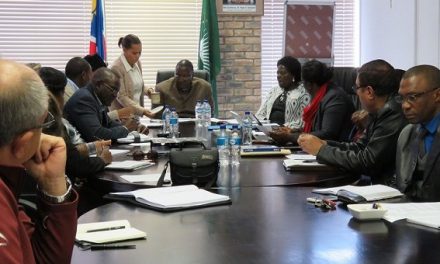
Survey reveals broad unemployment at 27.4%

Daniel Oherein – Deputy Director: Household, Welfare and Labour Statistics, Liina Kafidi, Director for Demographic and Social Statistics and Dr. John Steytler, Statistician General of Namibia Statistics Agency at the launch of the fifth Namibia Labour Force Survey 2012 Report (Photograph by Hilmah Hashange)
The broad unemployment consisted of all the people within the economically active population or working age group who are either without work or available for work, irrespective of whether they are seeking work or not.
The survey collected data on the labour market activities of individuals aged 15 years and above who lived in Namibia during the reference period. Respondents who participated as part of the survey were interviewed in their private households.
From the total population of 2 million people, 66 % of the Namibian population aged 15 years and above falls in the economically active group which is the labour force while 31 % fall outside the labour force. A total of 9108 households were interviewed with 506 sampling units having taken part in the survey which took place across the country from 16 October to 27 October 2012.
While the results indicate that 27.4 % of the labour force are unemployed, 72.6% are said to be employed.
The group with the highest unemployment rate is still the age category of 15 to 19 years at 56% followed by the 20 to 24 category at 49%. The category with the lowest unemployment rate is 50 to 54 at 13%.
Women posted the highest unemployment number at 31.8% while people in urban areas are more likely to be unemployed than those living in rural areas. The Ohangwena region recorded the highest unemployment rate of 34.6% while the Karas region had the lowest unemployment rate of 23.9%.
The findings show a positive correlation between education and employment. Those with tertiary education, certificate and diploma as well as teachers training, recorded an unemployment rate of less than 10%.
The survey also revealed that the majority of the labour force is employed in the subsistence agricultural sector which represents 15.8% of all employed people.
Although the 2011 Namibia Population and Housing Census recorded a 37% unemployment rate, Dr. John Steytler, Statistician General of the Namibia Statistics Agency (NSA) pointed out that the differences in the estimates can be attributed to the detailed coverage of labour force variables in the survey compared to the 2011 census. “ While the census had only one question which was used to determine the employment status, the labour force survey of 2012 had nine questions which were used to filter out in more detail the employed and unemployed persons,” Steytler said.
Steytler also cautioned that movements in the labour force indicators from previous periods should not be attributed to specific policy interventions during the review period as the methodologies employed between previous surveys and the current survey are not consistent.
He highlighted some of the key changes which the NSA brought to the 2012 survey such as a significant increased of 65% in the sample size compared to the previous surveys as well as the increased number of questions from two to nine in the 2012 survey. Steytler says the increase in sample size and sampling units was necessitated by the fact that the previous survey had a high sampling error.
“As a result of these improvements, today’s results present the most accurate data and labour force information and constitute the official situation about employment and unemployment in Namibia,” Steytler said during the launch. He said the unemployment rate should be prioritised and said that more funding is needed to carry out labour surveys more frequently. He also hinted on the possibility of conducting another survey later this year again.
It is the fifth survey conducted since Independence and the first to be conducted by the Namibia Statistics Agency in collaboration with the Ministry of Labour and Social Welfare.
Documents which provide more details on various elements of the survey are available on the NSA’s website which Steytler said will also provide data and statistics collected for any future survey conducted by the NSA.












































